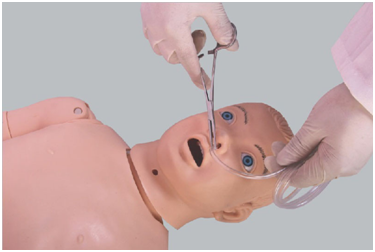29-04-2024
ADA MED SUPPLY LIMITED
In the medical field, pediatric nasogastric tubes are increasingly used, and their unique advantages play an irreplaceable role in pediatric care. The pediatric nasogastric feeding tube model, as a professional medical teaching tool, accurately simulates this process, providing strong support for medical staff to deeply understand and master the advantages of pediatric nasogastric feeding tubes.

First of all, the biggest advantage of pediatric nasogastric tubes is that they are non-invasive. Compared with traditional gastric tubes, nasogastric tubes do not need to be inserted through the mouth or esophagus, avoiding possible damage and discomfort. This feature is particularly important for pediatric patients because their anatomy is more delicate and their tolerance for stimulation is limited. The design of the pediatric nasogastric tube model completely restores this process, and medical staff can deeply appreciate its non-invasive advantages in actual operation.
Secondly, nasogastric feeding tubes for children also have the characteristics of high feeding efficiency and good nutrient absorption. Through the nasogastric tube, medical staff can directly deliver the nutritional solution to the child's stomach, avoiding feeding difficulties caused by oral or esophageal problems. At the same time, since the nutrient solution enters the stomach directly, its absorption efficiency is also greatly improved, which is helpful for the recovery and growth of pediatric patients. In model training, medical staff can simulate the delivery of different types of nutrient solutions to understand their impact on pediatric patients, so as to better master feeding skills.
In addition, pediatric nasogastric feeding tubes also have the advantages of easy operation and high safety. Medical staff only need to gently insert the nasogastric tube into the child's nostril to complete the entire operation. At the same time, the design of the nasogastric feeding tube also fully considers safety factors, such as soft material, moderate tube diameter, and easy fixation, ensuring that it will not cause any harm to pediatric patients during use. Through model training, medical staff can become more familiar with and master the operating procedures of the nasogastric tube, ensuring that they can be completed accurately in actual operations.
The emergence of the pediatric nasogastric feeding tube model provides medical staff with a real and controllable practice environment, allowing them to deeply understand and master the advantages of pediatric nasogastric feeding tubes. Through continuous simulation training, medical staff can become more proficient in the operation skills of nasogastric tubes and provide safer and more efficient care services for pediatric patients.
In short, the pediatric nasogastric feeding tube model fully demonstrates the advantages of pediatric nasogastric feeding tubes with its precise simulation and high degree of simulation. It is believed that in the future medical field, this model will play a more important role and contribute more to the healthy growth of pediatric patients.